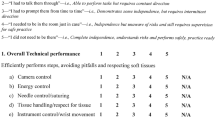Abstract
There is currently no standardized robotic surgery training program in General Surgery Residency. RAST involves three modules: ergonomics, psychomotor, and procedural. This study aimed to report the results of module 1, which assessed the responsiveness of 27 PGY (postgraduate year) 1–5 general surgery residents (GSRs) to simulated patient cart docking, and to evaluate the residents’ perception of the educational environment from 2021 to 2022. GSRs prepared with pre-training educational video and multiple-choice questions test (MCQs). Faculty provided one-on-one resident hands-on training and testing. Nine proficiency criteria (deploy cart; boom control; driving cart; docking camera port; targeting anatomy; flex joints; clearance joints; port nozzles; emergency undocking) were assessed with five-point Likert scale. A validated 50-item Dundee Ready Educational Environment Measure (DREEM) inventory was used by GSRs to assess the educational environment. Mean MCQ scores: (90.6 ± 16.1 PGY1), (80.2 ± 18.1PGY2), (91.7 ± 16.5 PGY3) and (PGY4, 86.8 ± 18.1 PGY5) (ANOVA test; p = 0.885). Hands-on docking time decreased at testing when compared to base line: median 17.5 (range 15–20) min vs. 9.5 (range 8–11). Mean hands-on testing score was 4.75 ± 0.29 PGY1; 5.0 ± 0 PGY2 and PGY3, 4.78 ± 0.13 PGY4, and 4.93 ± 0.1 PGY5 (ANOVA test; p = 0.095). No correlation was found between pre-course MCQ score and hands-on training score (Pearson correlation coefficient = − 0.359; p = 0.066). There was no difference in the hands-on scores stratified by PGY. The overall DREEM score was 167.1 ± 16.9 with CAC = 0.908 (excellent internal consistency). Patient cart training impacted the responsiveness of GSRs with 54% docking time reduction and no differences in hands-on testing scores among PGYs with a highly positive perception.




Similar content being viewed by others
Data availability
The data that support the findings of this study are available upon request.
References
Wormer BA, Dacey KT, Williams KB, Bradley JF 3rd, Walters AL, Augenstein VA et al (2014) The first nationwide evaluation of robotic general surgery: a regionalized, small but safe start. Surg Endosc 28(3):767–776
Liu R, Liu Q, Wang Z (2021) Worldwide diffusion of robotic approach in general surgery. Updates Surg 73(3):795–797
Essani R, Scriven RJ, McLarty AJ, Merriam LT, Ahn H, Bergamaschi R (2009) Simulated laparoscopic sigmoidectomy training: responsiveness of surgery residents. Dis Colon Rectum 52(12):1956–1961
Castaldi M, Palmer M, Con J, Abouezzi Z, Latifi R, Bergamaschi R (2021) Robotic-assisted surgery training (RAST) program: an educational research protocol. Surg Technol Int 38:52–55
Herron DM, Marohn M, Group S-MRSC (2008) A consensus document on robotic surgery. Surg Endosc 22(2):313–325 (Discussion 1-2)
Tom CM, Maciel JD, Korn A, Ozao-Choy JJ, Hari DM, Neville AL et al (2019) A survey of robotic surgery training curricula in general surgery residency programs: how close are we to a standardized curriculum? Am J Surg 217(2):256–260
Hutchins EB (1961) The 1960 medical school graduate: his perception of his faculty, peers, and environment. J Med Educ 36:322–329
Chen R, Rodrigues Armijo P, Krause C, Force SRT, Siu KC, Oleynikov D (2020) A comprehensive review of robotic surgery curriculum and training for residents, fellows, and postgraduate surgical education. Surg Endosc 34(1):361–367
Green CA, Chern H, Rogers SJ, Reilly LM, O’Sullivan P (2021) Transforming surgical education through a resident robotic curriculum. Ann Surg Open 2(3):e076
Lee JY, Mucksavage P, Sundaram CP, McDougall EM (2011) Best practices for robotic surgery training and credentialing. J Urol 185(4):1191–1197
Winder JS, Juza RM, Sasaki J, Rogers AM, Pauli EM, Haluck RS et al (2016) Implementing a robotics curriculum at an academic general surgery training program: our initial experience. J Robot Surg 10(3):209–213
Crawford DL, Dwyer AM (2018) Evolution and literature review of robotic general surgery resident training 2002–2018. Updates Surg 70(3):363–368
Moit H, Dwyer A, De Sutter M, Heinzel S, Crawford D (2019) A standardized robotic training curriculum in a general surgery program. JSLS 23(4):e2019.00045
Acknowledgements
The authors are extremely grateful to the faculty instructors Ziad E. Abouezzi, MD, Ryan F. Bendl, MD, Francis X. Carroll, MD, and Ashutosh Kaul, MD. The authors also thank the general surgery residency office staff for their invaluable support in facilitating the residents’ participation to the training sessions.
Author information
Authors and Affiliations
Corresponding author
Ethics declarations
Conflict of interest
All authors disclose financial or non-financial interests that are directly or indirectly related to the work submitted for publication.
Research involving human and animal rights
This study was performed in line with the principles of the Declaration of Helsinki.
Informed consent
Informed consent was obtained from all individual participants included in the study.
Additional information
Publisher's Note
Springer Nature remains neutral with regard to jurisdictional claims in published maps and institutional affiliations.
Supplementary Information
Below is the link to the electronic supplementary material.
Supplementary file2 Instruction video (MP4 149733 KB)
13304_2023_1485_MOESM4_ESM.docx
Supplementary file4 Box plots depicting stratification of mean MCQ score and mean hands-on training score by gender (DOCX 94 KB)
Rights and permissions
Springer Nature or its licensor (e.g. a society or other partner) holds exclusive rights to this article under a publishing agreement with the author(s) or other rightsholder(s); author self-archiving of the accepted manuscript version of this article is solely governed by the terms of such publishing agreement and applicable law.
About this article
Cite this article
Castaldi, M.T., Palmer, M., Felsenreich, D.M. et al. Robotic-assisted surgery training (RAST) program: module 1 of a three-module program. Assessment of patient cart docking skills and educational environment. Updates Surg 75, 825–835 (2023). https://doi.org/10.1007/s13304-023-01485-9
Received:
Accepted:
Published:
Issue Date:
DOI: https://doi.org/10.1007/s13304-023-01485-9




